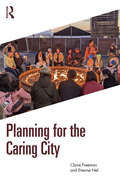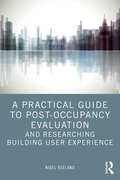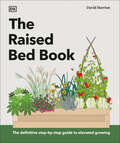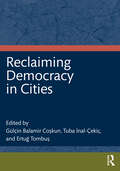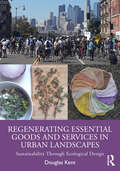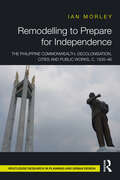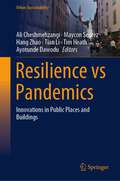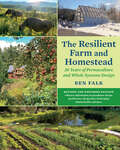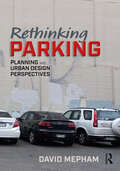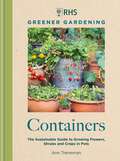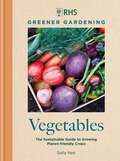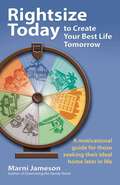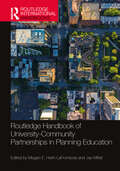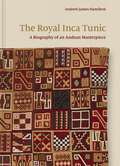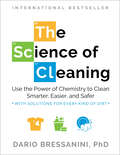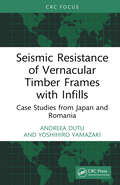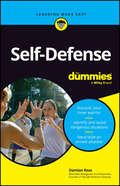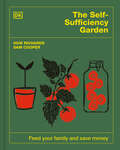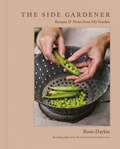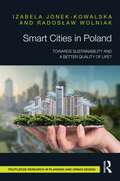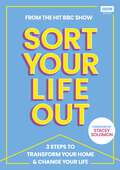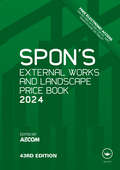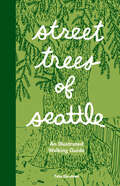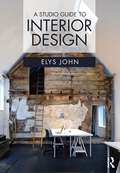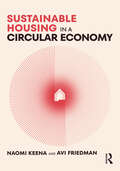- Table View
- List View
Planning for the Caring City
by Claire Freeman Etienne NelAs the world has become increasingly urbanised and planetary well-being ever more threatened, questions have emerged over just what the priorities should be for how we live in cities. Clearly for many the current ways of planning and managing city environments are not working, given so many of their human and non-human inhabitants struggle on a daily basis to maintain their well-being and survival. Different approaches to city development are crucial if they are to be inclusive places where all can thrive. Ensuring that cities are safe and sustainable and provide a level of care for all their residents places a significant mandate on those who manage cities and on planners in particular. This book examines all the parts of the city where care needs to be incorporated, how we plan, create nurturing environments, include all who live there, build sensitively, support meaningful livelihoods, and enable compassionate governance. With planners in mind this book examines why care is needed in the urban environment, and drawing on real world examples examines how it can be applied in an effective and empowering fashion.
A Practical Guide to Post-Occupancy Evaluation and Researching Building User Experience
by Nigel OselandA Practical Guide to Post-Occupancy Evaluation offers high-level pragmatic guidance and case study examples on how to conduct a Post-Occupancy Evaluation (POE) to determine whether a workplace project is successful and uncover the lessons learned for future projects. For designers, POEs provide essential predesign feedback, informing the design brief to determine occupant requirements and help focus expenditure. For those in charge of a building or buildings, POE offers proactive building management and can also be used as part of the change management programme in larger projects, informing the occupants of progress. The practical guidance offered in this book will help the workplace industry understand if a design meets the requirements of an occupier and measure the success of and value offered by a workplace project. This book will be of interest to professionals in the workplace industry responsible for delivering and evaluating capital projects as well as those studying interior design, architecture, surveying, facilities management and building services engineering.
The Raised Bed Book: Get the Most from Your Raised Bed, Every Step of the Way
by DKWhether you want to garden at a more accessible height, improve soil fertility, nurture plants with needs, or simply enjoy a closer sensory experience, growing in raised beds will help you reach new heights in the garden.Raised beds are possible in any-size garden, even on balconies, but it needs expert advice to create the optimum growing conditions, achieve the most practical use of space tailored to your individual needs, and ensure longevity of the raised bed structure. Featuring clear diagrams, inspired planting plans, and step-by-step photography of beds built from scratch, this book will be the ultimate guide on your raised bed journey.In addition, 10 international gardeners, all sharing a love of raised beds, will explain their "take" and provide planting designs that will open your eyes to the variety of shapes, sizes, materials, and planting displays that are possible with a raised bed. From placing and designing, choosing materials, and growing media, to ongoing maintenance and how best to care for your plants, The Raised Bed Book is the final word on growing above ground.
Reclaiming Democracy in Cities
by Gülçin Balamir Coşkun Tuba İnal-Çekiç Ertuğ TombuşEffective urban governance is essential in responding to the challenges of inequality, migration, public health, housing, security, and climate change. Reclaiming Democracy in Cities frames the city as a political actor in its own right, exploring the city’s potential to develop deliberative and participatory practices which help inform innovative democratic solutions to modern day challenges.Bringing together expertise from an international selection of scholars from various fields, this book begins with three chapters which discuss the theoretical idea of the democratic city and the real-world applicability of such a model. Part II discusses new and innovative democratic practices at the local level and asks in what way these practices help us to rethink democratic politics, institutions, and mechanisms in order to move toward a more egalitarian, pluralist, and inclusive direction. Drawing on the Istanbul municipal elections and the Kurdish municipal experience, Part III focuses on the question of whether cities and local governments can lead to the emergence of strong democratic forces that oppose authoritarian regimes. Finally, Part IV discusses urban solidarity networks and collaborations at both the local level and beyond the nation, questioning whether urban solidarity networks and alliances with civil society or transnational city networks can create alternative ways of thinking about the city as a locus of democracy.This edited volume will appeal to academics, researchers, and advanced students in the fields of urban studies, particularly those with an interest in democratic theory; local democracy; participation and municipalities. It will also be relevant for practitioners of local governments, NGOs, and advocacy groups and activists working for solidarity networks between cities.
Regenerating Essential Goods and Services in Urban Landscapes: Sustainability Through Ecological Design
by Douglas KentHow do we provide for and nurture millions of people without destroying the planet in the process? Author Doug Kent, an environmental specialist, believes a vital element in the solution is recognizing that urban landscapes are an essential partner in everyone’s wellbeing. He argues that urban landscapes can and must work harder.Urban landscapes can provide part of our energy needs, help cool our buildings and public spaces, help us make the most of our precious water. They can also help combat air pollution and reduce the likelihood of allergies and asthma. They can provide landscape materials and even contribute to our timber supply. Doug also advocates turning landscapes into a food source, and/or a perfumery, pharmacy, soap shop, or craft store.Doug has over 12 years of research in this book. He has spent years doing literature reviews, and many more years concocting, consuming, crafting, distilling, propagating, retting, sawing, sowing, and weaving its many recommendations. He has also travelled the length and width of California many times to interview the people and businesses already doing this incredible work.Regenerating Essential Goods and Services is not a manifesto. It is a user’s manual. You are the creative and energetic force that will ultimately drive sustainability and regeneration. Let’s go.
Remodelling to Prepare for Independence: The Philippine Commonwealth, Decolonisation, Cities and Public Works, c. 1935–46
by Ian MorleyRemodelling to Prepare for Independence: The Philippine Commonwealth, Decolonisation, Cities and Public Works, c. 1935–46 illuminates the implications of the USA’s final phase of colonial rule in the Philippine Islands. It explores the Filipino side of decolonisation and the management of the built environment in the years immediately prior to self-rule. This book shakes off the collaboration vs. resistance paradigm that empire histories generally follow and consequently yields an original vantage point to comprehend transition within an Asian society in the years immediately prior to, during, and after World War Two. This will not only deepen insight of the American Empire, but also grants the opportunity to tie Philippine political-cultural change to the global history of urban planning’s advancement. Accordingly, it opens a new window to rethink Filipino ethno-history and societal evolution, alongside the opportunity to compare the Philippines with other nations that undertook planning projects as part of their decolonisation process and early-postcolonial advancement. The book utilises theoretical frames in order to help creatively excavate the era 1935–46 for the purpose of not just revealing what public works occurred, but to also uncover what those projects meant to the Commonwealth Government, the BPW’s staff, and the public who benefitted from public works projects. The book will be relevant to students and researchers of Urban History, Asian and American (Empire) History, and Imperial and Colonial Studies. Architects, planners, and members of the public who are interested in the form and meaning of urban environments designed/constructed in the past will also find the publication to be of great interest.
Resilience vs Pandemics: Innovations in Public Places and Buildings (Urban Sustainability)
by Ali Cheshmehzangi Maycon Sedrez Hang Zhao Tian Li Tim Heath Ayotunde Dawodu“Resilience vs Pandemics: Innovations in Public Places and Buildings” explores innovative solutions for architecture and public places during and after the pandemic. Additionally, the authors contribute to the documentation of architectural and social transformations that have been prompted by previous transmissible diseases, as this knowledge can inform responses to future pandemics. In this volume, the chapters present critical, exploratory, multi- and interdisciplinary, and cutting-edge research approaches; with a particular focus on the effects of COVID-19 and other highly transmissible diseases on the design, use, performance, and perception of the built environment, particularly at the building scale. This volume aims to organize a collection of scientific studies, reviews, analysis, recommendations, and solutions in the fields of urban design, architecture, design, landscape design, etc. The overarching goal is to document new approaches to create and enhance built environment resilience. Chapters shed light on novel methods, tools, processes, regulations, behaviours, and other relevant details contributing to a comprehensive understanding of this crucial issue. The two scales of the built environment under consideration are: (1) Public Places, including research on transformations (death, emergencies, changes), requirements, adaptability, usability, virtual immersion, historical perspectives, interactivity, shifts in use and programs, etc.(2) Buildings, including regulations, shifts in use and program, non-pharmaceutical interventions, human interactions, and human-machine interfaces. The book covers a wide range of studies, including physical and non-physical studies, which may refer to the city infrastructure, green/blue spaces, housing, policy-making, health services, social and economic issues, etc. The findings and results of various global case study examples contribute to the decision-making of governments, organizations, and institutions, as well as inspire scholars and future research for developing resilience in the post-pandemic era.
The Resilient Farm and Homestead, Revised and Expanded Edition: 20 Years of Permaculture and Whole Systems Design
by Ben Falk“This is one of the most practical, down-to-earth, dirt-under-the-fingernails, comprehensive explanations of all things homesteading and small farming. Whether you’re just dreaming or an old hand, Ben Falk’s longer experience horizon is invaluable.”—Joel Salatin, cofounder, Polyface Farm; author of Everything I Want to Do Is Illegal Informed by twenty years of successful land management and the professional design experience of his pioneering firm Whole Systems Design, LLC, author Ben Falk updates his classic text and delivers the definitive twenty-first century systems thinking manual in self-reliance—sure to empower readers to prioritize projects, make positive lifestyle decisions, and take strategic steps toward a regenerative future. In The Resilient Farm and Homestead, Revised and Expanded Edition Falk describes how he has transformed a degraded hillside in the frigid Vermont climate into a thriving, biodiverse Eden that now provides year-round abundance for his family and community. First published in 2013, The Resilient Farm and Homestead is a comprehensive how-to guide for building durable and productive land-based systems through the reciprocal interplay of humans and the natural world. In the ten years since he first published this seminal work, Falk has deepened his wisdom in harnessing nature-based solutions for increasingly challenging times, including addressing severe climate disruptions like drought and flood conditions. The book covers every strategy Falk and his team have tested on the Whole Systems Research Farms over the past two decades and includes detailed information on earthworks, gravity-fed water systems, soil fertility management, growing nutrient-dense food and medicine, fuelwood production, agroforestry, managed grazing, and much more. Complete with full-color photography and detailed design drawings, The Resilient Farm and Homestead, Revised and Expanded Edition includes new information on: Designing greenhouses and microclimates Reinvigorating human health and embodying a vigorous lifestyle Raising children on a homestead Creating failure-proof and resilient energy systems Focusing on permaculture beekeeping Cultivating proven cold climate plants Overcoming analysis paralysis and mastering the art of knowing where to start and when to take strategic risks And much, much more! In an age that feels defined by disconnection, disease, and decline, The Resilient Farm and Homestead, Revised and Expanded Edition offers a roadmap to conquering uncertainty, maximizing efficiency, and creating a bountiful, manageable landscape that will endure. “Essential reading for the serious prepper as well as for everyone interested in creating a more resilient lifestyle.”—Carol Deppe, author of The Resilient Gardener “This intelligent, challenging book, rooted somewhere between back-to-the-land idealism and radical survivalism, sees resilience as both planting and building for the use of future generations, but also as preparing food, water, shelter, and the human body and psyche for the onset of any imaginable extreme emergency. . . . The result is a comprehensive, open-ended, theoretical and practical system for a post-carbon-dependent life.”—Publishers Weekly (starred review of first edition)
Rethinking Parking: Planning and Urban Design Perspectives
by David MephamFor much of the past century, we have viewed the issue of parking from the driver’s seat. It follows that key narratives about parking reaffirm the immediate needs of the driver. A consequence of this approach is a failure to understand the significant damage that parking causes to the destination. That damage is amplified by ‘cheap, easy’ parking at the expense of place and access outcomes. Viewing parking from an urban planning and design perspective highlights different issues and opportunities. Five perspectives are offered: Place – If we gave drivers all the parking they wanted, the destination would not be worth visiting. Politics – Parking is intensely territorial, emotional, and prone to populism, and this is a barrier to strategic and sustainable parking reform. Policy – Parking tends to be focused on the ‘me, here and now’ needs of the driver at the expense of bigger picture and longer term policy objectives. Price – Subsidized parking exists behind opaque pricing mechanisms. In contrast, a transparent accounting of costs is a vehicle for strategic parking reform. Professional practice – Parking is a significant land-use issue, located at the juncture of transport and urban planning and design. Improving urban parking outcomes requires an integrated and collaborative planning process. An alternative view of parking is timely as new technologies and economies fundamentally change everything we understand about parking. A potential paradigm shift is in the making. Rethinking Parking provides a pathway to a better parking/place balance and access to destinations worth visiting. It is valuable reading for students and professionals engaged in transport, planning, urban access, and design.
RHS Greener Gardening: the sustainable guide to growing flowers, shurbs and crops in pots
by Ann Treneman Royal Horticultural SocietyThis complete primer on how to make an eco-friendly container garden is dedicated to showing that everyone can have a garden, no matter the size, that can benefit the planet.RHS Greener Gardening: Containers guides you through greener choices when it comes to creating a container garden including materials, design, plant choice and maintenance. A few pots on the patio or a window box can become a dynamic mini eco system. A balcony garden can attract wildlife. With the right plants to choose from, a patio can hold an orchard. It's all a matter of 'thinking green', using recycled materials when possible, being wildlife-friendly, choosing plants that will avoid waste, and gardening sustainably.Featuring an easy-to-follow guide to green techniques as well as a helpful series of plant profiles, this is the perfect handbook for a sustainable container garden. Sections include:- Setting up your container garden- Container gardening techniques: sourcing plants, containers & contents, watering, feeding & troubleshooting- Creating containers: growing in groups, choosing a theme, how to create a map or a plan
RHS Greener Gardening: The sustainable guide to growing planet-friendly crops
by Sally Nex Royal Horticultural SocietyBuild your vegetable garden on sustainable, eco-friendly foundations from the start with this new guide to growing your own fresh, organic food. Greener Gardening: Vegetables is the perfect handbook for all seasons, helping budding and experienced gardeners alike in their journey towards a greener way of gardening. The book covers:- Setting up a new vegetable garden so it works hard for you and the environment- A wide ranging directory of vegetables organized by harvesting season- Methods for sowing and growing, plus advice on troubleshooting and saving seed- 'Tasks to do' reminders for keeping on top of garden maintenance each season- 'Do It Greener' reminders of quick and easy way to get greener results You will find new ideas on every page to keep your garden productive and sustainable for years to come.
Rightsize Today to Create Your Best Life Tomorrow: A Motivational Guide for Those Seeking Their Ideal Home Later in Life
by Marni JamesonA gentle guide for helping readers &“over a certain age&” discover their best life by finding the right-sized home in the best location.Moving is no fun. Neither is getting rid of stuff. And both jobs get harder as we get older. So, when those over a certain age — say, in the last third of life — are looking to downsize and move all at the same time, many will conclude, &“I&’ll just stay put, thank you very much.&” It&’s not just the acquired possessions holding them back, but also the intangibles. Their memories, their family history, their identities are all in jeopardy, they think. And yet, that reluctance to lighten up, let go, and move on is commonly all that stands between them and a better life. Rightsize Today to Create Your Best Life Tomorrow will help this group of root-bound home dwellers cross the bridge between stuck in the past and a lighter, better future. It will encourage them to embrace the fact that now, when they&’re no longer tethered to a school system or to a job they need to be near, is their chance to live where they want to live. Every section contains checklists: some soul-searching (should you or shouldn&’t you move?), some practical (what every kitchen must have), and some logistical (where&’s your happy place?), to help readers on their journey. Included are enlightening profiles of those who proactively changed their housing in the last third of their life. Whether they moved to a smaller place, remodeled their existing home, or even moved to a larger home, which one third do; whether they moved to a new city, to a senior community, or to a new home in the same neighborhood, they all reimagined their lives, re-evaluated their belongings and made a move toward a better and possibly their best life yet. To live your best life now requires an honest appraisal of who you are and who you&’re becoming, where you are in your life and where you&’re going or want to go. This book is designed to help those who are stuck explore what&’s holding them back, and provide them with the insights, experiences, and courage to move forward.
Routledge Handbook of University-Community Partnerships in Planning Education (Routledge International Handbooks)
by Heim LaFrombois, Megan E. Jay MittalThis handbook explores two guiding questions – how can university-community partnerships in planning education work, and how can they be transformative? University-community partnerships – often referred to as service-learning or community-engaged teaching and learning – are traditionally based on a collaborative relationship between an academic partner and a community-based partner, in which students from the academic partner work within the community on a project. Transformational approaches to university-community partnerships are approaches that develop and sustain mutually beneficial collaborations where knowledge is co-created and new ways of knowing and doing are discovered. This edited volume examines a variety of university-community partnerships in planning education, from a number of different perspectives, with a focus on transformative models. The authors explore broader theoretical issues, including topics relating to pedagogy, planning theory, and curriculum; along with more practical topics relating to best practices, logistics, institutional support, outcome measures, and the various forms these partnerships can take – all through an array of case studies. The authors, which include academics, professional practitioners, academic practitioners, and students, bring an incredible depth and breadth of knowledge and experience from across the globe – Australia, Canada, Chile, Europe (including Germany, Spain, Slovakia, and Sweden), India, Jamaica, South Korea, and the United States.
The Royal Inca Tunic: A Biography of an Andean Masterpiece
by Andrew James HamiltonThe hidden life of the greatest surviving work of Inca artThe most celebrated Andean artwork in the world is a five-hundred-year-old Inca tunic made famous through theories about the meanings of its intricate designs, including attempts to read them as a long-lost writing system. But very little is really known about it. The Royal Inca Tunic reconstructs the history of this enigmatic object, presenting significant new findings about its manufacture and symbolism in Inca visual culture.Andrew James Hamilton draws on meticulous physical examinations of the garment conducted over a decade, wide-ranging studies of colonial Peruvian manuscripts, and groundbreaking research into the tunic&’s provenance. He methodically builds a case for the textile having been woven by two women who belonged to the very highest echelon of Inca artists for the last emperor of the Inca Empire on the eve of the Spanish invasion in 1532. Hamilton reveals for the first time that this imperial vestment remains unfinished and has suffered massive dye fading that transforms its appearance today, and he proposes a bold new conception of what this radiant masterpiece originally looked like.Featuring stunning photography of the tunic and Hamilton&’s own beautiful illustrations, The Royal Inca Tunic demonstrates why this object holds an important place in the canon of art history as a deft creation by Indigenous women artists, a reminder of the horrors of colonialism, and an emblem of contemporary Andean identity.
The Science of Cleaning: Use The Power Of Chemistry To Clean Smarter, Easier, And Safer-with Solutions For Every Kind Of Dirt
by Dario BressaniniThe definitive, science-backed guide to cleaning everything in your home in a safe, sustainable, evidence-based way “A great reference for anyone stumped by reluctant-to-leave dirt—and far cheaper than hiring a professional.”—Booklist Countless cleaning hacks for every kind of household dirt may vie for our attention, but how do we know which ones really work and which ones will only leave you with a sticky mess that doesn’t actually do the job? Scientific evidence comes to the rescue, as chemistry professor Dario Bressanini teaches you everything worth knowing about cleaning agents and processes (and dispels plenty of myths, too). He answers all of our most pressing housekeeping questions: Is it more efficient to wash dishes in the sink or in the dishwasher? Does bleach remove dirt? Which cleaning supplies should I buy, and which can I make at home? Can vinegar and baking soda actually unclog your drain? How can I most effectively tackle different types of stains? What can get rid of that stuff on my showerhead? Bressanini covers subjects like these by digging into chemistry basics such as solubility, pH, and concentration, bringing them out of the classroom and into the real-world chores that we deal with every day. Laundry, dishes, sinks, bathtubs, counters, floors, and more—no matter what you’re cleaning, this book explains how to choose the right tools for the task, save yourself unnecessary effort, and stay eco-friendly by avoiding waste. The Science of Cleaning reminds us that science can be both useful and exciting. With Bressanini’s help, you can keep your home, your belongings, and yourself clean—with the confidence that only centuries of advancements in chemistry can provide.
Seismic Resistance of Vernacular Timber Frames with Infills: Case Studies from Japan and Romania
by Andreea Dutu Yoshihiro YamazakiThis book provides an engineer’s perspective on the traditional construction methods for timber frames with infills, focusing on traditional paianta houses in Romania and minka houses in Japan to provide insights into the construction, seismic behavior, and design considerations of such structures.The nuances of each country’s traditional construction methods are considered, as well as the shared seismic culture and the similar functionality and local materials used for the houses, plus challenges from earthquake loading and fire. The efforts to preserve traditional houses in Romania are contrasted with Japan’s regulatory framework for traditional residential construction methods. Strengthening solutions are also proposed for timberframed houses with infills, considering various causes of degradation.• Introduces examples from non- seismic and seismic- prone countries.• Provides a comparative analysis of worldwide examples.• Presents design examples illustrating the integration of traditional architecture with modern design standards.The book serves as a comprehensive guide to the engineering intricacies of traditional houses in Romania and Japan for engineers and architects, with practical applications for new constructions worldwide.
Self-Defense For Dummies
by Damian RossGet street-smart. Unleash your inner warrior. Forget everything you thought you knew about self-defense. Those graceful martial arts moves that are so effective in the movies are likely to get you killed on the street. In fight-or-flight mode, you won’t have the calm thinking and fine motor skills to execute them. You need a simpler approach with a few fundamental moves that are easy to remember and perform yet devastating to an attacker. The solution? Self-Defense For Dummies, your guide to avoiding attacks, neutralizing attackers, and protecting yourself and your loved ones. In this book, you discover a self-defense system that works in the real world, where armed criminals target the most vulnerable and don’t fight fair. Discover strategies to make yourself a hard target, as opposed to an easy one Heighten your awareness of your surroundings and potential threats Sharpen your self-defense instincts and respond proactively to impending danger Master hand-to-hand combat basics and defend against grabs and holds Learn how to use weapons and defend against them
The Self-Sufficiency Garden: Feed Your Family and Save Money: THE #1 SUNDAY TIMES BESTSELLER
by Huw Richards Sam CooperEat homegrown food all year round and save money on your weekly shop by following a simple plan for self-sufficiency.Huw Richards and Sam Cooper have spent the past two years planning and trialing their self-sufficiency garden in a 10x13m plot, and now they've worked out the perfect formula. Grow six portions of nutritious veg a day per person following their month-by-month growing plan, which is realistic and flexible with cost, space, and time in mind. Follow this carefully curated year-round growing plan to yield six portions of veg per person per day, plus batching and preserving recipes! Whether you are looking for cost-effective ways to put food on the table and feed your family, a fan of Huw’s YouTube videos and would like to try out the recipes for yourself or a gardener who would like some guidance on how to grow your own food, this book will be great for you.With this gardening book, you will be able to:-Learn about Huw's self-sufficiency ethos, goals, and approaches to growing food-Create your garden and learn how to build all the growing spaces you will need, such as hotbeds and polytunnels-Follow month-by-month planting plans with guidance on key tasks throughout the year and different seasons-Perfect your growing skills with sowing, weeding, watering, and composting.-Discover useful kitchen tips for meal prep, storage, and preserving ideas along with base recipes so you can make the most of your crops. -Find recipes for delicious dishes including soup, curry, tray bakes and salads + dressingsFollow Huw Richards and SamCooper’s tried-and-tested methods and save money while enjoying homegrown food all year. If you are interested in learning more or want more books by Huw Richards, check out these titles: Veg in One Bed, Grow Food For Free, and The Vegetable Grower's Handbook.
The Side Gardener: Recipes & Notes from My Garden
by Rosie DaykinA cookbook of vegetable-forward recipes celebrating the beauty of freshly grown produce.The Side Gardener is the story of how Rosie Daykin—a bestselling and award-winning cookbook author who also happens to garden a little on the side—turned a languishing patch of land beside her home into an informal working garden.With love and attention, the garden blossomed with a bounty of fresh vegetables and fruit, a near endless supply of beautiful flowers for cutting, and even a few eggs from three very naughty chickens. Rosie shares her notes on how she designed her garden and nurtured it to life, along with the simple recipes she created to let the freshly grown produce shine. Inside, you&’ll find sides and snacks, salads and soups, mains and desserts, all shown through the captivating lens of revered British photographer Andrew Montgomery. Whether the produce you use is from your garden or local market, Rosie&’s elegant recipes will help you celebrate the honest flavors of fruits and vegetables. Filled with witty anecdotes and gorgeous photography, The Side Gardener is all the inspiration you need to create and cook from a garden of your own, no matter the size.
Smart Cities in Poland: Towards sustainability and a better quality of life?
by Izabela Jonek-Kowalska Radosław WolniakThis book considers and examines the concept of a Smart City in the context of improving the quality of life and sustainable development in Central and Eastern European cities. The Smart City concept has been gaining popularity in recent years, with supporters considering it to be an effective tool to improve the quality of life of the city’s residents. In turn, opponents argue that it is a source of imbalance and claim that it escalates the problems of social and economic exclusion. This book, therefore, assesses the quality of life and its unsustainability in Central and Eastern European cities within the context of the Smart City concept and from the perspective of key areas of sustainable development. Using case studies of selected cities in Central and Eastern Europe and representative surveysof Polish cities, this book illustrates the process of creating smart cities and their impact on improving the quality of life of citizens. Specifically, this book investigates the conditions that a Smart City has to meet to become sustainable, how the Smart City concept can support the improvement of the residents’ quality of life and how Central and Eastern European countries create smartcity solutions. Containing both theoretical and practical content, this book will be of relevance to researchers and students interested in smart cities and urban planning, as well as city authorities and city stakeholders who are planning to implement the Smart City concept.
SORT YOUR LIFE OUT: 3 Steps to Transform Your Home & Change Your Life
by The BBC teamThe first official book from the life-changing BBC One show, Sort Your Life Out will have you falling back in love with your home in three simple steps:1. STRIP - how to let go and clear out the clutter (when you don't have a warehouse to hand)!2. SORT - time to sell, donate, recycle and upcycle.3. SYSTEMISE - learn how to organise, fold and store in a way that is manageable and sustainable.Filled with every tip and trick from your favourite experts Stacey, Dilly, Iwan and Rob, this empowering book will give you the tools to transform your home and get that Sort Your Life Out mindset.
Spon's External Works and Landscape Price Book 2024 (Spon's Price Books)
Compiled by AECOM, the 2024 edition has been updated with the latest pricing information to help you manage your projects over the next 12 months through this challenging period of high inflation and financial uncertainty. It covers all the items to be found in hard and soft landscape contracts, and forms an indispensable reference book for quantity surveyors, landscape architects, contractors and local authority managers – essential for compiling estimates, specifications, bills of quantities and works schedules – no matter what the size of the project being undertaken. All prices have been updated via a short-term inflationary forecast combined with AECOM’s market intelligence to ensure you have the most accurate cost data available. Activity descriptions and build ups have been updated to reflect changes to standard specifications, Building Regulation changes, emerging practices, and changing outputs All the standard features you have come to expect from SPON'S are also included: Material and measured work prices covering contract items from preliminaries and site clearance and encompassing the core external works activities Full breakdowns into labour, materials and other components Detailed guidance on wage rates, landscape consultants’ fee scales An extensive Approximate Estimates section for rapid spot estimating Included within the inside front cover of every book is a VitalSource eBook redemption code giving one user access to the content digitally until the end of December 2024.
Street Trees of Seattle: An Illustrated Walking Guide
by Taha EbrahimiThe majestic trees of Seattle's neighborhoods take center stage in this illustrated and informative walking guide. Want to discover which neighborhood has the highest concentration of cherry street trees when cherry blossoms are at their peak?Eager to stroll down the only street lined with western red cedars?Curious how monkey puzzle trees made their way to the city?Using data visualization as a starting point, the author takes readers on a tour of existing street trees throughout Seattle's neighborhoods and iconic parks through charming illustrations and maps. In the process, she educates readers on the history of the trees and the city, and offers up sketches of trees, leaves, and leaflets to identify trees throughout 33 different neighborhoods. The most notable of each species are highlighted, so urban adventurers can fully appreciate their surroundings or design their own walking routes to experience these natural wonders in their favorite areas of the city.The book is organized alphabetically by neighborhood and each area: Showcases a species of treeIncludes a history of the tree and neighborhoodOffers maps and callouts for spotting the best street specimens In an increasingly digital world, the book invites readers to slow down and embrace an analog approach to tree-spotting during their urban meanderings.
A Studio Guide to Interior Design
by Elys JohnA Studio Guide to Interior Design leads you through the creative process of developing an interior design proposal. From reading existing buildings, to presenting the final design, each stage is illustrated with analytical diagrams demonstrating clearly the workflow, processes and skills needed at each stage of the design process. Throughout the book there are key references to drawing, digital practice, author illustrated diagrams and design precedents. The book shows how to effectively read existing architecture and interiors and sets out orthographic drawing principles, to be used as an integral part of conceptual design development. It also looks at the integration of technology within the design process. The book has a complementary focus towards hand drawing and digital practice and uses a case study driven, diagrammatic approach so students can readily apply programmatic concepts to their own project context. Ideally suited to students at the beginning of their course, the book covers everything students need to get to grips with early on in their studies and features a wealth of pedagogical features.
Sustainable Housing in a Circular Economy
by Naomi Keena Avi FriedmanThis book relates circular economy principles to housing design and construction and highlights how those principles can result in both monetary savings, positive environmental impact, and socio-ecological change.Chapters focus on three key circular economy principles and apply them to architectural construction and design, namely rethinking of the end-of-use phase of a building and the potential of design-for-disassembly; the role of digitization and data standardization in fostering evidence-based circular economy design decision-making; and presenting space as a resource to conserve, via exploration of the sharing economy and flexibility principles. Beyond waste management and material cycles, this book provides a holistic understanding of the opportunities across the building life cycle that can allow for sustainable and affordable circular housing. With case studies from 13 different countries, including but not limited to the Hammarby Sjöstad district in Sweden, the Circle House in Denmark, Benny Farm in Canada, VMD Prefabricated House in Mexico, and the Deep Performance Dwelling in China, authors pair theoretical frameworks with real-world examples.This will be a useful resource for upper-level students and academics of architecture, construction, and planning, especially those studying and researching housing design, building technology, green project management, and environmental design.
